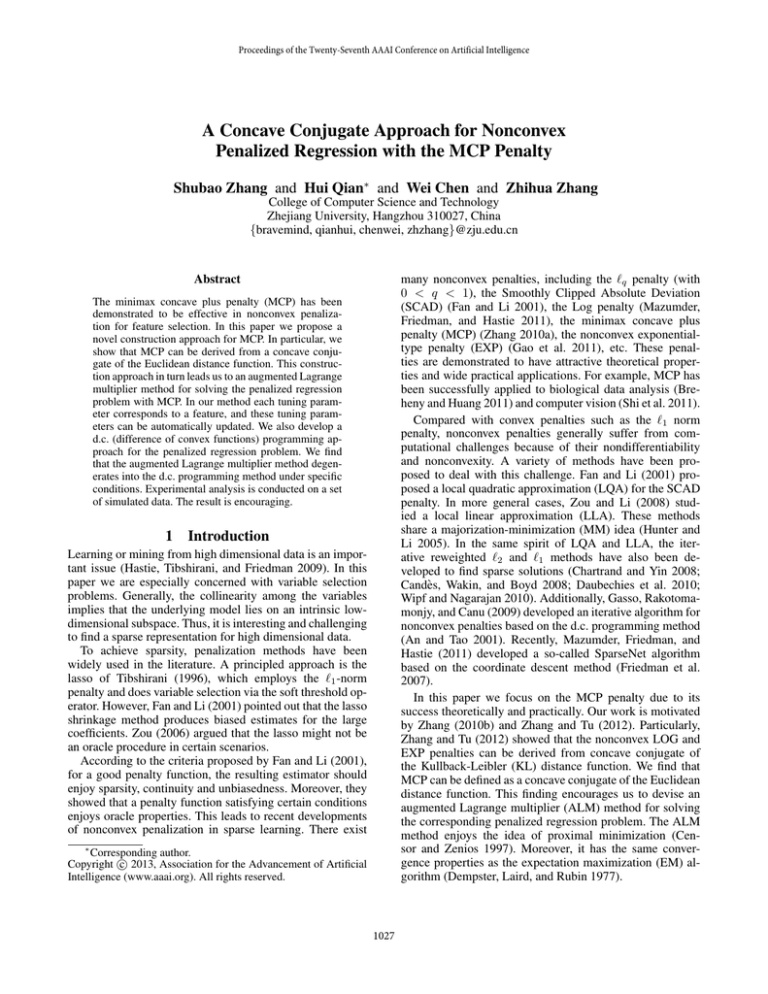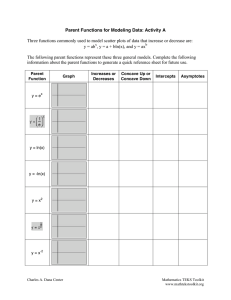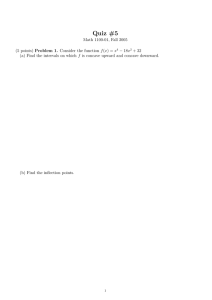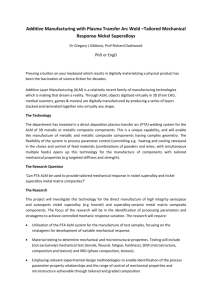
Proceedings of the Twenty-Seventh AAAI Conference on Artificial Intelligence
A Concave Conjugate Approach for Nonconvex
Penalized Regression with the MCP Penalty
Shubao Zhang and Hui Qian∗ and Wei Chen and Zhihua Zhang
College of Computer Science and Technology
Zhejiang University, Hangzhou 310027, China
{bravemind, qianhui, chenwei, zhzhang}@zju.edu.cn
many nonconvex penalties, including the q penalty (with
0 < q < 1), the Smoothly Clipped Absolute Deviation
(SCAD) (Fan and Li 2001), the Log penalty (Mazumder,
Friedman, and Hastie 2011), the minimax concave plus
penalty (MCP) (Zhang 2010a), the nonconvex exponentialtype penalty (EXP) (Gao et al. 2011), etc. These penalties are demonstrated to have attractive theoretical properties and wide practical applications. For example, MCP has
been successfully applied to biological data analysis (Breheny and Huang 2011) and computer vision (Shi et al. 2011).
Compared with convex penalties such as the 1 norm
penalty, nonconvex penalties generally suffer from computational challenges because of their nondifferentiability
and nonconvexity. A variety of methods have been proposed to deal with this challenge. Fan and Li (2001) proposed a local quadratic approximation (LQA) for the SCAD
penalty. In more general cases, Zou and Li (2008) studied a local linear approximation (LLA). These methods
share a majorization-minimization (MM) idea (Hunter and
Li 2005). In the same spirit of LQA and LLA, the iterative reweighted 2 and 1 methods have also been developed to find sparse solutions (Chartrand and Yin 2008;
Candès, Wakin, and Boyd 2008; Daubechies et al. 2010;
Wipf and Nagarajan 2010). Additionally, Gasso, Rakotomamonjy, and Canu (2009) developed an iterative algorithm for
nonconvex penalties based on the d.c. programming method
(An and Tao 2001). Recently, Mazumder, Friedman, and
Hastie (2011) developed a so-called SparseNet algorithm
based on the coordinate descent method (Friedman et al.
2007).
In this paper we focus on the MCP penalty due to its
success theoretically and practically. Our work is motivated
by Zhang (2010b) and Zhang and Tu (2012). Particularly,
Zhang and Tu (2012) showed that the nonconvex LOG and
EXP penalties can be derived from concave conjugate of
the Kullback-Leibler (KL) distance function. We find that
MCP can be defined as a concave conjugate of the Euclidean
distance function. This finding encourages us to devise an
augmented Lagrange multiplier (ALM) method for solving
the corresponding penalized regression problem. The ALM
method enjoys the idea of proximal minimization (Censor and Zenios 1997). Moreover, it has the same convergence properties as the expectation maximization (EM) algorithm (Dempster, Laird, and Rubin 1977).
Abstract
The minimax concave plus penalty (MCP) has been
demonstrated to be effective in nonconvex penalization for feature selection. In this paper we propose a
novel construction approach for MCP. In particular, we
show that MCP can be derived from a concave conjugate of the Euclidean distance function. This construction approach in turn leads us to an augmented Lagrange
multiplier method for solving the penalized regression
problem with MCP. In our method each tuning parameter corresponds to a feature, and these tuning parameters can be automatically updated. We also develop a
d.c. (difference of convex functions) programming approach for the penalized regression problem. We find
that the augmented Lagrange multiplier method degenerates into the d.c. programming method under specific
conditions. Experimental analysis is conducted on a set
of simulated data. The result is encouraging.
1
Introduction
Learning or mining from high dimensional data is an important issue (Hastie, Tibshirani, and Friedman 2009). In this
paper we are especially concerned with variable selection
problems. Generally, the collinearity among the variables
implies that the underlying model lies on an intrinsic lowdimensional subspace. Thus, it is interesting and challenging
to find a sparse representation for high dimensional data.
To achieve sparsity, penalization methods have been
widely used in the literature. A principled approach is the
lasso of Tibshirani (1996), which employs the 1 -norm
penalty and does variable selection via the soft threshold operator. However, Fan and Li (2001) pointed out that the lasso
shrinkage method produces biased estimates for the large
coefficients. Zou (2006) argued that the lasso might not be
an oracle procedure in certain scenarios.
According to the criteria proposed by Fan and Li (2001),
for a good penalty function, the resulting estimator should
enjoy sparsity, continuity and unbiasedness. Moreover, they
showed that a penalty function satisfying certain conditions
enjoys oracle properties. This leads to recent developments
of nonconvex penalization in sparse learning. There exist
∗
Corresponding author.
c 2013, Association for the Advancement of Artificial
Copyright Intelligence (www.aaai.org). All rights reserved.
1027
It is worth pointing out that there are multiple tuning (or
regularization) hyperparameters in our approach; namely,
each tuning parameter corresponds to a feature. This makes
our approach have stronger ability in sparse modeling than
the conventional setting (Mazumder, Friedman, and Hastie
2011). Moreover, the ALM algorithm can automatically update these tuning hyperparameters. For comparison, we also
devise a d.c. (difference of convex functions) programming
method for the MCP-based penalized regression problem.
When we set the tuning hyperparameters as an identical one
and prespecify it, our approach shares the same idea as the
d.c. programming method. Compared with the SparseNet
(Mazumder, Friedman, and Hastie 2011) which uses a twodimensional grid search for selecting two hyperparameters,
our approach only needs to select one hyperparameter via
grid search. Thus, our approach is more efficient.
The rest of the paper is organized as follows. First, we
give an overview of the problem, and introduce the MCP
penalty and the notion of concave conjugate. Then we expound our new idea over this problem and describe our
work. In the following section, we conduct an empirical
analysis. Finally, we conclude our work.
2
theoretical properties and successful applications, we are
mainly concerned with the use of MCP in the penalized regression problem in this paper.
2.1
The Minimax Concave Plus Penalty
The MCP function is defined as
|t| x
dx
1−
pγ (t; λ) = λ
γλ +
0
= (λ|t| −
λ2 γ
t2
)I(|t| < λγ) +
I(|t| ≥ λγ)
2γ
2
(1)
for λ > 0 and γ > 0, where I is the indicator function
and (z)+ = max(z, 0). With the MCP function in (1), the
penalized regression problem is
1
min ||y − Xβ||22 + Pγ (β; λ)
(2)
β 2
p
where Pγ (β; λ) = j=1 pγ (βj ; λ).
The MCP function and its first-order derivative are depicted in Figures 1 and 2 respectively. Recently, Mazumder,
Friedman, and Hastie (2011) showed that for each value of
λ > 0 there is a continuum of penalties and threshold operators as γ varying from ∞ to 1+, which corresponds to
the soft threshold operator and the hard threshold operator
respectively. Therefore, the MCP at γ → ∞ and γ → 1+
performs like the 1 penalty and the 0 penalty respectively.
Zhang (2010a) proved that the MCP function can result in
a nearly unbiased estimate. In this paper we introduce the
notion of concave conjugate to further explore MCP.
Problem Formulation
Consider the linear regression problem
y = Xβ + ,
where X = [x1 , . . . , xn ]T ∈ Rn×p is an input matrix,
y = (y1 , . . . , yn )T ∈ Rn is the corresponding output vector,
β ∈ Rp is a vector of regression coefficients, and ∈ Rn
is a Gaussian error vector.
X and y are
n We assume
that
n
standardized
so
that
y
=
0,
x
i
i=1
i=1 ij = 0 and
n
2
x
=
1
for
all
j
=
1,
.
.
.
,
p.
Our
aim is to find a
i=1 ij
sparse estimate of the regression vector β = (β1 , . . . , βp )T
under the regularization framework.
The classical regularization framework is based on a
penalty function of β. That is
1
min y − Xβ22 + P (β; λ),
β 2
p
where P (β; λ) =
j=1 p(βj ; λj ) is the penalty that
achieves sparsity in the coefficients, and λj is the tuning (or
regularization) parameter controlling the tradeoff between
the loss function and the penalty.
A widely used setting for penalty is P (β; λ) =
p
λ j=1 pj (βj ), which implies that the penalty function consists of p separable subpenalties and all subpenalties share a
common tuning parameter λ. In order to find a sparse solution of β, one imposes the 0 -norm penalty β0 to β (i.e.,
the number of nonzero elements of β). However, the resulting optimization problem is NP-hard. The 1 -norm penalty
p
P (β; λ) = λβ1 = λ j=1 |βj | is an effective convex
alternative for the nonconvex 0 -norm penalty.
Recently, some nonconvex alternatives, such as the q
penalty (q ∈ (0, 1)), log-penalty, SCAD and MCP, have
been employed. Meanwhile, iteratively reweighted q (q = 1
or 2) minimization or coordinate descent methods were developed for finding sparse solutions. Since MCP has good
2
1.8
gamma=3.7
gamma=2.0
gamma=0.1
1.6
1.4
1.2
1
0.8
0.6
0.4
0.2
0
−10
−8
−6
−4
−2
0
2
4
6
8
10
Figure 1: The MCP function for different values of γ.
2.2
Concave Conjugate
Given a function f : S ⊆ Rp → (−∞, ∞), its concave
conjugate, denoted by g, is defined by
g(v) = inf {uT v − f (u)}.
u∈S
It is well known that g is concave whether or not f is concave. However, if f is proper, closed and concave, the concave conjugate of g is again f (Boyd and Vandenberghe
2004).
1028
As we know, the existing methods such as SparseNet directly solve the problem (2) with setting of λ1 = · · · = λp λ > 0. Moreover, λ as well as γ are usually selected via the
cross validation or grid search. In this paper we consider the
case that the λj ’s are not necessary identical and have the
following regularization optimization problem
1
0.9
gamma=3.7
gamma=2.0
gamma=0.1
0.8
0.7
0.6
0.5
0.4
min
β ,λ
0.3
0.2
J(β, λ) p
1
y − Xβ22 +
λj Ψγ (|βj |) . (4)
2
j=1
0.1
0
−10
−8
−6
−4
−2
0
2
4
6
8
According to the construction of MCP based on concave
conjugate, we consider an equivalent alternative as follows
1
γ
min min y − Xβ22 + ω T |β| + ω − λ22 . (5)
2
β ,λ ω ≥0 2
10
Figure 2: The first-order derivative of MCP for different values of γ.
3.1
We note that Wipf and Nagarajan (2010) used the idea of
concave conjugate to express the automatic relevance determination (ARD) cost function, and Zhang (2010b) derived
the bridge penalty by using the idea of concave conjugate.
Recently, Zhang and Tu (2012) derived the LOG and EXP
penalties from concave conjugate of the Kullback-Leibler
(KL) divergence. We will see that the MCP function can also
be derived out under the framework of concave conjugate.
3
Methodology
ω (k) = argmin F (ω|β (k) , λ(k) ),
ω >0
In this section we first give a new construction approach for
the MCP function based on concave conjugate. Using this
construction approach, we then develop an augmented Lagrange multiplier method for solving the corresponding penalized regression problem.
Given two non-negative vectors ω = (ω1 , . . . , ωp )T and
λ = (λ1 , . . . , λp )T , we consider the following concave conjugate problem:
γ
min ω T |β| + ω − λ22 , γ > 0
(3)
ω ≥0
2
where F (ω|β (k) , λ(k) ) is given as
F (ω|β (k) , λ(k) ) (k)
ωj |βj | +
γ
ω − λ(k) 22 .
2
The second step then calculates β (k+1) and λ(k+1) via
(β (k+1) , λ(k+1) )
p
1
γ
(k)
2
y−Xβ2 +
ωj |βj |+ ω (k) −λ22 .
= argmin
2
2
β, λ
j=1
Note that given ω (k) , β and λ are independent. Thus the
second step can be partitioned into two parts; namely,
γ
λ(k+1) = argmin ω (k) − λ22
2
λ
Theorem 1 Let Pγ (β; λ) denote
p the minimum of the problem in (3). Then Pγ (β; λ) = j=1 λj Ψγ (|βj |) where
1
if |βj | ≥ λj γ,
2 λj γ
Ψγ (|βj |) =
βj2
|βj |− 2λj γ otherwise.
and
β (k+1) = argmin
β
Moreover, the minimum value is attained when
0
if |βj | > λj γ,
ωj =
λ − 1 |β | otherwise.
γ
p
j=1
w.r.t. |β| = (|β1 |, . . . , |βp |)T . We have the following theorem.
j
The Augmented Lagrange Multiplier Method
In this section, we deal with the problem (5) in which λ
is also a vector that needs to be estimated. W resort to an
augmented Lagrange multiplier (ALM) algorithm (Censor
and Zenios 1997) to solve the problem.
In particular, we are given initial values ω (0) , e.g., ω (0) =
ε(1, . . . , 1)T where ε > 0 is prespecified. After the kth estimates (β (k) , λ(k) ) of (β, λ) are obtained, the (k+1)st iteration of the ALM algorithm consists of two steps. The first
step calculates ω (k) via
1
2
y − Xβ22 +
p
j=1
(k)
ωj |βj | .
The former part shows that the ALM enjoys the idea behind
the proximal minimization (Censor and Zenios 1997). The
latter part is a reweighted 1 minimization problem which
can be solved by the coordinate descent method. We summary the implementation of ALM in Algorithm 1.
Unlike the SparseNet algorithm which uses a twodimensional grid search for selecting the hyperparameters
γ and λ, the ALM method only needs to select γ. Thus
j
The proof of this theorem is easily obtained. Since the Euclidean distance ω−λ22 is strictly convex in ω, Pγ (β; λ)
can be viewed as the concave conjugate of −γ/2ω−λ22 .
Interestingly, if letting λ1 = · · · = λp λ > 0, we see that
Pγ (β; λ) becomes the conventional MCP. Thus, we derive
out MCP under the framework of concave conjugate.
1029
Let A(β (k) , λ(k) ) be the set of values of (β, λ) that minimize Q(β, λ|β (k) , λ(k) ) over Ω ⊂ Rp ×Rp++ and S be the
set of stationary points of Q in the interior of Ω. We can
immediately derive the following theorem from Zangwill’s
global convergence theorem or the literature (Wu 1983;
Sriperumbudur and Lanckriet 2009).
Algorithm 1 The ALM Algorithm
Input: {X = [x1 , . . . , xn ]T , y}, γ, ω (0)
while β (k+1) − β (k) 2 < τ do
Update
ω (k) = argmin
ω ≥0
p
j=1
(k)
ωj |βj | +
γ
ω − λ(k) 22 ,
2
Theorem 2 Let {β (k) , λ(k) } be a sequence of the ALM algorithm generated by (β (k+1) , λ(k+1) ) ∈ A(β (k) , λ(k) ).
Suppose that (i) A(β (k) , λ(k) ) is closed over the complement of S and (ii)
and the update rule is the following:
(k)
(k)
0
if |βj | > λj γ,
(k)
ωj =
(k)
(k)
λj − γ1 |βj | otherwise.
J(β (k+1) , λ(k+1) ) < J(β (k) , λ(k) )for all (β (k) , λ(k) ) ∈ S.
Update
λ
(k+1)
=ω
(k)
Then all the limit points of {β (k) , λ(k) } are stationary points
of J(β, λ) and J(β (k) , λ(k) ) converges monotonically to
J(β ∗ , λ∗ ) for some stationary point (β ∗ , λ∗ ).
,
p
1
(k)
y − Xβ22 +
ωj |βj | .
β (k+1) = argmin
2
β
j=1
4
For comparison, in this section, we devise a d.c. (DC) programming method for the penalized regression problem with
the MCP penalty, which follows the method of Gasso, Rakotomamonjy, and Canu (2009). The key idea is to consider a
proper decomposition of the objective function, converting
the nonconvex penalized regression problem into a convex
reweighted 1 minimization problem. Particularly, we decompose the penalty Pγ (β; λ) as
end while
Output: β
our ALM method is more efficient than SparseNet. Also the
ALM method bears an interesting resemblance to the EM algorithm, because we can treat ω as missing data. With such
a treatment, the first step of ALM is related to the E-step of
EM, which calculates the expectations associated with missing data.
3.2
Pγ (β; λ) = λβ1 − H(β)
for some H(β). Accordingly, we decompose the original
optimization problem in (2) as
Convergence Analysis
min{G(β) − H(β)}
β
We now investigate the convergence property of the ALM
algorithm. Our analysis is based on the optimization problem in (4) with the objective function J(β, λ). Noting that
ω (k) is a function of β (k) and λ(k) , we denote the objective
function in the second step of ALM by
Q(β, λ|β (k) , λ(k) ) +
The DC Programming Method
where G(β) = 12 y − Xβ22 + λβ1 . This is the primal
problem. The corresponding dual problem is
min{H ∗ (α) − G∗ (α)}
α
p
1
(k)
y−Xβ22 +
ωj |βj |
2
j=1
where H ∗ and G∗ represent the corresponding Fenchel conjugates (Borwein and Lewis 2000).
With a local linear approximation, the above primal-dual
pair problem evolves into the following equivalent problem:
γ (k)
ω −λ22 .
2
∂G∗ (α ) = argmin{G(β) − β, α },
β
∂H(β ) = argmin{H ∗ (α) − α, β },
α
We have the following lemma.
Lemma 1 Let {(β (k) , λ(k) ) : k = 1, 2, . . .} be a sequence
defined by the ALM algorithm. Then,
(6)
(7)
with equality if and only if β (k+1) = β (k) and λ(k+1) =
λ(k) .
where α ∈ ∂H(β (k) ) and β ∈ ∂G∗ (α(k) ). If H(β) is differentiable, the subdifferential in (7) is a singleton so that
∂H(β ) = {H(β)}. For MCP, it is just the first-order
derivative. Then we obtain a reweighted 1 minimization
problem
Since J(β (k) , λ(k) ) ≥ 0, this lemma shows that
J(β (k) , λ(k) ) converges monotonically to some J ∗ ≥ 0. In
fact, the ALM algorithm enjoys the same convergence as the
standard EM algorithm (Dempster, Laird, and Rubin 1977).
where α = H(β). And this problem can be efficiently
solved via the coordinate descent method.
J(β
(k+1)
,λ
(k+1)
) ≤ J(β
(k)
,λ
(k)
),
1
argmin{ y − Xβ22 + λβ1 − α, β}
2
β
1030
Algorithm 2 The DC Algorithm
Input: {X = [x1 , . . . , xn ]T , y}, γ, λ
Initialization: α(0) = 0 and β (0) = 0.
while ||β (k+1) − β (k) ||2 < τ do
Update
βj /γ
if |βj | < λγ,
αj =
λ ∗ sign(βj ) otherwise,
Table 1: Simulated results of SparseNet, DC and ALM.
A LGORITHM
n = 50, SN R = 3
S PARSE N ET M
S PARSE N ET R
DC
ALM
n = 50, SN R = 10
S PARSE N ET M
S PARSE N ET R
DC
ALM
n = 100, SN R = 3
S PARSE N ET M
S PARSE N ET R
DC
ALM
n = 100, SN R = 10
S PARSE N ET M
S PARSE N ET R
DC
ALM
where α is the derivative of the MCP penalty.
Update
ωj = λ − αj ∗ sign(βj ).
Update
p
1
2
β = argmin{ ||y − Xβ||2 +
ωj |βj |}.
2
β
j=1
end while
Output: β
Based on the above analysis, we develop the DC algorithm for the penalized regression. The algorithm constructs
two sequences {α(k) } and {β (k) } and stops until convergence. Essentially, this DC method is the same to the LLA
method, as both of them involve a local linear approximation. The procedure is presented in Algorithm 2.
Interestingly, Eqns. (6) and (7) suggest that the DC
method is in fact derived from the concave conjugate theory.
Indeed, the ALM algorithm degenerates to the DC algorithm
when we set λ = λ(1, . . . , 1)T and specify λ. However, the
advantage of the ALM method over the DC method is in that
the ALM method allows each tuning parameter corresponding to a feature. Moreover, these tuning parameters can be
automatically updated during the ALM iteration.
5
AVERAGE SPE
AVERAGE FSE
4.4289( ±1.1320)
1.9518(±0.5569)
2.2003 (± 0.6880)
2.2780(± 0.8000)
0.1946( ±0.0144)
0.1038(±0.0685)
0.0703(± 0.0762)
0.0533(± 0.0480)
7.7827(± 3.788)
1.8839(±0.4152)
2.5743(± 0.9746)
2.7288(± 0.9006)
0.1468(± 0.0192)
0.0755(± 0.0435)
0.0238(± 0.0204)
0.0178(± 0.0174)
4.6127(± 0.8042)
1.2996(±0.0899)
1.3883(± 0.1849)
1.4140(± 0.3010)
0.4007(± 0.0281)
0.0755(±0.0552)
0.0455 (± 0.0400)
0.0270(± 0.0277)
6.1749(± 2.6990)
1.2720 (±0.1432)
3.0134(± 2.2871)
2.9553(± 2.3128)
0.3172(± 0.0205)
0.0448(± 0.0313)
0.0175(± 0.0238)
0.0022(± 0.0035)
Σ = {0.7|i−j| }1≤i,j≤200 . We choose a σ satisfying
β T Σβ
,
SN R =
σ
in which SNR is the signal-to-noise ratio. Numerical experiments are carried out with different n and SNR values. In
particular, we also take an experiment in the case with a
high signal-to-noise ratio. For each test, m = 1000 testing
instances are generated. To assess the performance of the algorithms, we use the Standardized Prediction Error (SPE)
and Feature Selection Error (FSE) as the assessment criterion. The SPE is defined as
m
(yi − xTi β̂)2
SP E = i=1
.
mσ 2
Experimental Analysis
In this section we conduct experimental analysis of the ALM
and DC algorithms. For comparison, we use two SparseNet
algorithms: SparseNet R and SparseNet M. The former is
from the standard R package of SparseNet. And the latter is
implemented using Matlab without the df calibration technique that suggested in (Mazumder, Friedman, and Hastie
2011). We use cross validation to select the hyperparameters λ and γ in the DC algorithm. For the ALM algorithm,
we set ω (0) = ε1T , in which ε is chosen via cross validation
too. For τ , the threshold of termination criterion, we set it as
10−4 in our numerical experiments.
We take experiments on a set of simulated datasets. To
generate the datasets, we employ the following data model.
That is,
y = xT β + σ,
And the FSE is the proportion of coefficients in β̂ which is
not correctly set to zero or non-zero based on the true β.
We set up our experimental program as follows. Four
sets of data are generated with SN R = {3, 10} and n =
{50, 100}, respectively. We repeat all the algorithms with
20 times for each dataset. The reported results are based on
these 20 repeats.
Table 1 reports the prediction mean and the corresponding
standard deviation over 20 runs. And Figures 3 and 4 exhibit
the average result over 20 runs with the box-and-whisker
plot. The results show that ALM works better than the other
three methods in feature selection accuracy. This strongly
demonstrates the merit of ALM. Since in ALM each tuning
parameter corresponds to a feature and the tuning parameter
is automatically updated, ALM is more capable of selecting
the correct features. As for prediction accuracy, SparseNet R
performs the best because of its adoption of calibration technique. When no calibration technique is used for further performance improvement, ALM and DC perform better than
where ∼ N (0, 1). The coefficient vector β is a 200dimensional vector with 10 non-zero elements which are
determined by βi = βi+100 , i = 1, . . . , 5. We sample
the observation data x from a multivariate Gaussian distribution which has a zero mean and a covariance matrix
1031
0.3
0.16
0.12
0.25
0.14
0.25
0.1
0.2
0.12
0.2
0.08
0.1
0.15
0.06
0.08
0.15
0.1
0.06
0.04
0.04
0.02
0.1
0.05
0.05
0.02
0
0
1
2
3
n = 50 and SN R = 3
0
1
2
1
3
n = 100 and SN R = 3
2
3
n = 50 and SN R = 10
1
2
3
n = 100 and SN R = 10
Figure 3: Feature Selection Error. Here “1,” “2,” and “3” are for SparseNet R, DC and ALM respectively.
4.5
2.2
4.5
4
2
4
1.8
3.5
3.5
9
8
7
6
3
3
1.6
5
2.5
2.5
1.4
2
4
3
2
1.2
2
1.5
1.5
1
1
1
2
3
n = 50 and SN R = 3
1
2
1
3
n = 100 and SN R = 3
2
3
n = 50 and SN R = 10
1
2
3
n = 100 and SN R = 10
Figure 4: Prediction Errors. Here “1,” “2,” and “3” are for SparseNet R, DC and ALM respectively.
γ
1
y−Xβ (k+1) 22 + min ω T β (k+1) + ω−λ(k+1) 22
ω >0
2
2
γ
1
(k+1) 2
(k+1)
2 +(ω (k) )T β
+ ω (k) −ω (k) 22
≤ y−Xβ
2
2
1
y−Xβ22 + (ω (k) )T β
= min
β 2
SparseNet M in both prediction accuracy and feature selection accuracy. In addition, we can see that DC and ALM perform almost equally with respect to the prediction accuracy.
However, ALM achieves a lower feature selection error. It
just demonstrates ALM’s strong ability in feature selection.
We also find that ALM has a better convergence property
than DC in the practical experiments. Usually, ALM takes
less iterations than DC to converge.
6
=
γ
1
y−Xβ (k) 22 +(ω (k) )T β (k) + ω (k) − ω (k−1) 22
2
2
1
γ
= y−Xβ (k) 22 + min ω T β (k) + ω−λ(k) 22
ω >0
2
2
1
= y−Xβ (k) 22 + Pγ (β k ; λ(k) )
2
= J(β k , λ(k) ).
≤
Conclusion
In this paper we have studied the penalized regression problem with the MCP penalty. In particular, we have proposed a
new construction of MCP based on concave conjugate of the
Euclidean distance function. Accordingly, we have devised
an ALM method for solving the corresponding penalized regression problem. Additionally, we have revealed the relationship between the ALM method and the DC method for
MCP. The ALM method has an advantage in the automatic
choice of the tuning (or regularization) parameters in comparison with the DC method and the SparseNet. Numerical
experiments have demonstrated computational efficiency of
our ALM as well as its ability in sparse modeling.
A
Acknowledgments
Zhihua Zhang acknowledges support from the Natural Science Foundations of China (No. 61070239). Shubao Zhang,
Wei Chen and Hui Qian acknowledge support from the Natural Science Foundations of China (No. 90820306).
References
The Proof of Lemma 1
An, L. T. H., and Tao, P. D. 2001. Dc programming approach
and solution algorithm to multidimensional scaling problem.
Nonconvex optimization and its application 231–276.
Borwein, J. M., and Lewis, A. S. 2000. Convex analysis and
nonlinear optimization. New York: Springer.
Consider that
J(β (k+1) , λ(k+1) )
1
= y−Xβ (k+1) 22 + Pγ (β (k+1) ; λ(k+1) )
2
1032
Boyd, S., and Vandenberghe, L. 2004. Convex Optimization.
Cambridge, UK: Cambridge University Press.
Breheny, P., and Huang, J. 2011. Coordinate descent algorithms for nonconvex penalized regression, with applications to biological feature selection. Annals of Applied
Statistics 2:232–253.
Candès, E. J.; Wakin, M. B.; and Boyd, S. P. 2008. Enhancing sparsity by reweighted 1 minimization. The Journal of
Fourier Analysis and Applications 14(5):877–905.
Censor, Y., and Zenios, S. A. 1997. Parallel Optimization:
Theory, Algorithms, and Applications. Oxford, UK: Oxford
University Press.
Chartrand, R., and Yin, W. 2008. Iteratively reweighted algorithms for compressive sensing. In The 33rd IEEE International Conference on Acoustics, Speech, and Signal Processing (ICASSP).
Daubechies, I.; Devore, R.; Fornasier, M.; and Güntürk,
C. S. 2010. Iteratively reweighted least squares minimization for sparse recovery. Communications on Pure and Applied Mathematics 63(1):1–38.
Dempster, A. P.; Laird, N. M.; and Rubin, D. B. 1977. Maximum likelihood from incomplete data via the EM algorithm.
Journal of the Royal Statistical Society Series B 39(1):1–38.
Fan, J., and Li, R. 2001. Variable selection via nonconcave
penalized likelihood and its oracle properties. Journal of the
American Statistical Association 96(456):1348–1360.
Friedman, J. H.; Hastie, T.; Hoefling, H.; and Tibshirani, R.
2007. Pathwise coordinate optimization. The Annals of Applied Statistics 2(1):302–332.
Gao, C.; Wang, N.; Yu, Q.; and Zhang, Z. 2011. A feasible
nonconvex relaxation approach to feature selection. In Proceedings of the Twenty-Fifth AAAI Conference on Artificial
Intelligence.
Gasso, G.; Rakotomamonjy, A.; and Canu, S. 2009. Recovering sparse signals with a certain family of non-convex
penalties and dc programming. In IEEE Transactions on
Signal Proessing, volume 57, 4686–4698.
Hastie, T. J.; Tibshirani, R. J.; and Friedman, J. 2009. The
Elements of Statistical Learning: Data Mining, Inference,
and Prediction. Springer-Verlag, second edition.
Hunter, D., and Li, R. 2005. Variable selection using MM
algorithms. The Annals of Statistics 33(4):1617–1642.
Mazumder, R.; Friedman, J.; and Hastie, T.
2011.
SparseNet: Coordinate descent with nonconvex penalties.
Journal of the American Statistical Association
106(495):1125–1138.
Shi, J.; Ren, X.; Dai, G.; Wang, J.; and Zhang, Z. 2011. A
non-convex relaxation approach to sparse dictionary learning. In Proceedings of the International Conference on
Computer Vision and Pattern Recognition (CVPR).
Sriperumbudur, B. K., and Lanckriet, G. R. G. 2009. On the
convergence of the concave-convex procedure. In Advances
in Neural Information Processing Systems 22.
Tibshirani, R. 1996. Regression shrinkage and selection via
the lasso. Journal of the Royal Statistical Society, Series B
58:267–288.
Wipf, D., and Nagarajan, S. 2010. Iterative reweighted 1
and 2 methods for finding sparse solutions. IEEE Journal
of Selected Topics in Signal Processing 4(2):317–329.
Wu, C. F. J. 1983. On the convergence properties of the EM
algorithm. The Annals of Statistics 11:95–103.
Zhang, Z., and Tu, B. 2012. Nonconvex penalization using
laplace exponents and concave conjugates. In Advances in
Neural Information Processing Systems, 611–619.
Zhang, C.-H. 2010a. Nearly unbiased variable selection
under minimax concave penalty. The Annals of Statistics
38:894–942.
Zhang, T. 2010b. Analysis of multi-stage convex relaxation
for sparse regularization. Journal of Machine Learning Research 11:1081–1107.
Zou, H., and Li, R. 2008. One-step sparse estimates in nonconcave penalized likelihood models. The Annals of Statistics 36(4):1509–1533.
Zou, H. 2006. The adaptive lasso and its oracle properties. Journal of the American Statistical Association
101(476):1418–1429.
1033





